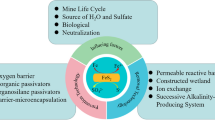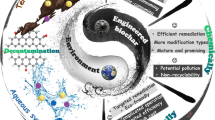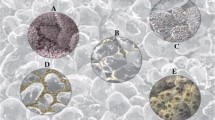Abstract
To more efficiently treat the dredged contaminated sediment (DCS) with a high water content, this study proposes an integrated method (called PHDVPSS) that uses the solidifying/stabilizing (S/S) agents and prefabricated horizontal drain (PHD) assisted by vacuum pressure (VP). Using this method, dewatering and solidification/stabilization can be carried out simultaneously such that the treatment time can be significantly shortened and the treatment efficacy can be significantly improved. A series of model tests was conducted to investigate the effectiveness of the proposed method. Experimental results indicated that the proposed PHDVPSS method showed superior performance compared to the conventional S/S method that uses Portland cement (PC) directly without prior dewatering. The 56-day unconfined compressive strength of DCS treated by the proposed method with GGBS-MgO as the binder is 12–17 times higher than that by the conventional S/S method. DCS treated by the PHDVPSS method exhibited continuous decrease in leaching concentration of Zn with increasing curing age. The reduction of Zn leachability is more obvious when using GGBS-MgO as the binder than when using PC, because GGBS-MgO increased the residual fraction and decreased the acid soluble fraction of Zn. The microstructure analysis reveals the formation of hydrotalcite in GGBS-MgO binder, which resulted in higher mechanical strength and higher Zn stabilization efficiency.

Similar content being viewed by others
References
Alp I, Deveci H, Süngün H (2008). Utilization of flotation wastes of copper slag as raw material in cement production. Journal of Hazardous Materials, 159(2–3): 390–395
ASTM D4219–08 (2008). Standard test method for unconfined compressive strength index of chemical-grouted soils. West Con-shohocken: ASTM International
Ben Haha M, Le Saout G, Winnefeld F, Lothenbach B (2011). Influence of activator type on hydration kinetics, hydrate assemblage and microstructural development of alkali activated blast-furnace slags. Cement and Concrete Research, 41(3): 301–310
Cai Y, Qiao H, Wang J, Geng X, Wang P, Cai Y (2017). Experimental tests on effect of deformed prefabricated vertical drains in dredged soil on consolidation via vacuum preloading. Engineering Geology, 222: 10–19
Cao X, Ma L Q, Chen M, Singh S P, Harris W G (2002). Impacts of phosphate amendments on lead biogeochemistry at a contaminated site. Environmental Science & Technology, 36(24): 5296–5304
Chai J, Hong Z, Shen S (2010). Vacuum-drain consolidation induced pressure distribution and ground deformation. Geotextiles and Geomembranes, 28(6): 525–535
Chen C F, Dong C D, Chen C W (2013). Metal speciation and contamination in dredged harbor sediments from Kaohsiung Harbor, Taiwan. Journal of Soil Contamination, 22(5): 546–561
Chew S H, Kamruzzaman A H M, Lee F H (2004). Physicochemical and engineering behavior of cement treated clays. Journal of Geotechni-cal and Geoenvironmental Engineering, 130(7): 696–706
China National Environmental Monitoring Center (1990). The Back¬ground Value of Soil Environment in China. Beijing: China Environmental Press
Cuisinier O, Le Borgne T, Deneele D, Masrouri F (2011). Quantification of the effects of nitrates, phosphates and chlorides on soil stabilization with lime and cement. Engineering Geology, 117(3–4): 229–235
Cuong D T, Obbard J P (2006). Metal speciation in coastal marine sediments from Singapore using a modified BCR-sequential extrac¬tion procedure. Applied Geochemistry, 21(8): 1335–1346
De Bruijn P B, Jeppsson K H, Sandin K, Nilsson C (2009). Mechanical properties of lime–hemp concrete containing shives and fibres. Biosystems Engineering, 103(4): 474–479
Du Y J, Bo Y L, Jin F, Liu C Y (2016a). Durability of reactive magnesia-activated slag-stabilized low plasticity clay subjected to drying–wetting cycle. European Journal of Environmental and Civil Engineering, 20(2): 215–230
Du Y J, Jiang N J, Liu S Y, Jin F, Singh D N, Puppala A (2014). Engineering properties and microstructural characteristics of cement-stabilized zinc-contaminated kaolin. Canadian Geotechnical Journal, 51(3): 289–302
Du Y J, Wei M L, Reddy K R, Wu H L (2016b). Effect of carbonation on leachability, strength and microstructural characteristics of KMP binder stabilized Zn and Pb contaminated soils. Chemosphere, 144: 1033–1042
Guevarariba A, Sahuquillo A, Rubio R, Rauret G (2004). Assessment of metal mobility in dredged harbour sediments from Barcelona, Spain. Science of the Total Environment, 321(1–3): 241–255
Ho L S, Nakarai K, Ogawa Y, Sasaki T, Morioka M (2017). Strength development of cement-treated soils: Effects of water content, carbonation, and pozzolanic reaction under drying curing condition. Construction & Building Materials, 134: 703–712
Hu P, Guo C S, Zhang Y, Lv J P, Zhang Y, Xu J (2019). Occurrence, distribution and risk assessment of abused drugs and their metabolites in a typical urban river in North China. Frontiers of Environmental Science & Engineering, 13(4): 56
Huang J, Huang R, Jiao J J, Chen K (2007). Speciation and mobility of heavy metals in mud in coastal reclamation areas in Shenzhen, China. Environmental Geology (New York, N.Y.), 53(1): 221–228
Indraratna B, Rujikiatkamjorn C, Ameratunga J, Boyle P (2011). Performance and prediction of vacuum combined surcharge consolidation at Port of Brisbane. Journal of Geotechnical and Geoenvironmental Engineering, 137(11): 1009–1018
Jin F, Al-Tabbaa A (2014). Evaluation of novel reactive MgO activated slag binder for the immobilization of lead and zinc. Chemosphere, 117: 285–294
Jin F, Gu K, Abdollahzadeh A, Al-Tabbaa A (2013). Effects of different reactive MgOs on the hydration of MgO-activated GGBS paste. Journal of Materials in Civil Engineering, 27(7): B4014001
Jin F, Gu K, Al-Tabbaa A (2014). Strength and drying shrinkage of reactive MgO modified alkali-activated slag paste. Construction & Building Materials, 51: 395–404
Kamruzzaman A H M, Chew S H, Lee F H (2006). Microstructure of cement-treated Singapore marine clay. Ground Improvement, 10(3): 113–123
Kogbara R B, Al-Tabbaa A, Yi Y, Stegemann J A (2013). Cement–fly ash stabilization/solidification of contaminated soil: performance properties and initiation of operating envelopes. Applied Geochem¬istry, 33: 64–75
Kotoky P, Bora B J, Baruah N K, Baruah J, Baruah P, Borah G C (2003). Chemical fractionation of heavy metals in soils around oil installations, Assam. Chemical Speciation and Bioavailability, 15 (4): 115–126
Liang X F, Zang Y B, Xu Y M, Tan X, Hou W G, Wang L, Sun Y B (2013). Sorption of metal cations on layered double hydroxides. Colloids and Surfaces. A, Physicochemical and Engineering Aspects, 433(20): 122–131
Lo I M C, Tang C I, Li X D, Poon C S (2000). Leaching and microstructural analysis of cement-based solidified wastes. Environ¬mental Science & Technology, 34(23): 5038–5042
Locat J, Bérubé M A, Choquette M (1990). Laboratory investigations on the lime stabilization of sensitive clays: shear strength development. Canadian Geotechnical Journal, 27(3): 294–304
Min F, Du J, Zhang N, Chen X, Lv H, Liu L, Yu C (2019). Experimental study on property change of slurry and filter cake of slurry shield under seawater intrusion. Tunnelling and Underground Space Technology, 88: 290–299
Muller G (1969). Index of geoaccumulation in sediments of the Rhine River. GeoJournal, 2: 108–118
Nagahara H, Fujiyama T, Ishiguro T, Ohta H (2004). FEM analysis of high airport embankment with horizontal drains. Geotextiles and Geomembranes, 22(1–2): 49–62
National Standards of the People’s Republic of China: State Technical Supervision Administration of the People’s Republic of China. Standard for soil test method, GB/T 50123–1999. Beijing: China Standards Publishing House
Passos E A, Alves J C, Dos Santos I S, Alves J P H, Garcia C A B, Spinola Costa A C (2010). Assessment of trace metals contamination in estuarine sediments using a sequential extraction technique and principal component analysis. Microchemical Journal, 96(1): 50–57
Qiao X C, Poon C S, Cheeseman C R (2007). Investigation into the stabilization/solidification performance of Portland cement through cement clinker phases. Journal of Hazardous Materials, 139(2): 238–243
Richardson I G, Groves G W (1992). Microstructure and microanalysis of hardened cement pastes involving ground granulated blast-furnace slag. Journal of Materials Science, 27(22): 6204–6212
Shen S L, Han J, Du Y J (2008). Deep mixing induced property changes in surrounding sensitive marine clays. Journal of Geotechnical and Geoenvironmental Engineering, 134(6): 845–854
Shinsha H, Kumagai T (2014). Bulk compression of dredged soils by vacuum consolidation method using horizontal drains. Geotechnical Engineering, 45(3): 78–85
Song S, Sohn D, Jennings H M, Mason T O (2000). Hydration of alkali-activated ground granulated blast furnace slag. Journal of Materials Science, 35(1): 249–257
Suthar S, Nema A K, Chabukdhara M, Gupta S K (2009). Assessment of metals in water and sediments of Hindon River, India: impact of industrial and urban discharges. Journal of Hazardous Materials, 171 (1–3): 1088–1095
US EPA (1992). EPA method 1311-toxicity characteristic leaching procedure. Washington, DC: United States Environmental Protection Agency
Wang D X, Abriak N E, Zentar R, Xu W (2012). Solidification/stabilization of dredged marine sediments for road construction. Environmental Technology, 33(1): 95–101
Wang F, Jin F, Shen Z, Al-Tabbaa A (2016). Three-year performance of in-situ mass stabilized contaminated site soils using MgO-bearing binders. Journal of Hazardous Materials, 318: 302–307
Wang F, Wang H, Jin F, Al-Tabbaa A (2015). The performance of blended conventional and novel binders in the in-situ stabilization/solidification of a contaminated site soil. Journal of Hazardous Materials, 285: 46–52
Wang H S, Tang C S, Gu K, Shi B, Inyang H I (2020). Mechanical behavior of fiber-reinforced, chemically stabilized dredged sludge. Bulletin of Engineering Geology and the Environment, 79(2): 629–643
Wang J, Ni J, Cai Y, Fu H, Wang P (2017). Combination of vacuum preloading and lime treatment for improvement of dredged fill. Engineering Geology, 227: 149–158
Wang S D, Scrivener K L (1995). Hydration products of alkali activated slag cement. Cement and Concrete Research, 25(3): 561–571
Xia W Y, Feng Y S, Jin F, Zhang L M, Du Y J (2017). Stabilization and solidification of a heavy metal contaminated site soil using a hydroxyapatite based binder. Construction & Building Materials, 156: 199–207
Xiao H, Wang W, Goh S H (2017). Effectiveness study for fly ash cement improved marine clay. Construction & Building Materials, 157: 1053–1064
Xu G Z, Gao Y F, Hong Z S, Ding J W (2012). Sedimentation behavior of four dredged slurries in China. Marine Georesources and Geotechnology, 30(2): 143–156
Yan S W, Chu J (2005). Soil improvement for a storage yard using the combined vacuum and fill preloading method. Canadian Geotechni-cal Journal, 42(4): 1094–1104
Yang Z, Wang Y, Shen Z, Niu J, Tang Z (2009). Distribution and speciation of heavy metals in sediments from the mainstream, tributaries, and lakes of the Yangtze River catchment of Wuhan, China. Journal of Hazardous Materials, 166(2–3): 1186–1194
Yi Y, Li C, Liu S, Jin F (2015). Magnesium sulfate attack on clays stabilised by carbide slag-and magnesia-ground granulated blast furnace slag. Geotechnique Letters, 5(4): 306–312
Yi Y, Liska M, Al-Tabbaa A (2012). Initial investigation into the use of GGBS-MgO in soil stabilization. In: Proceedings of the Fourth International Conference on Grouting and Deep Mixing 2012, New Orleans. New Orleans: Geotechnical Special Publication, 444–453
Yi Y, Liska M, Al-Tabbaa A (2014a). Properties and microstructure of GGBS–magnesia pastes. Advances in Cement Research, 26(2): 114–122
Yi Y, Liska M, Al-Tabbaa A (2014b). Properties of two model soils stabilized with different blends and contents of GGBS, MgO, lime, and PC. Journal of Materials in Civil Engineering, 26(2): 267–274
Yi Y, Liska M, Jin F, Al-Tabbaa A (2016). Mechanism of reactive magnesia–ground granulated blastfurnace slag (GGBS) soil stabili¬zation. Canadian Geotechnical Journal, 53(5): 773–782
Yousuf M, Mollah A, Vempati R K, Lin T C, Cocke D L (1995). The interfacial chemistry of solidification/stabilization of metals in cement and pozzolanic material systems. Waste Management (New York, N.Y.), 15(2): 137–148
Żak R, Deja J (2015). Spectroscopy study of Zn, Cd, Pb and Cr ions immobilization on C–S–H phase. Spectrochimica Acta. Part A: Molecular and Biomolecular Spectroscopy, 134: 614–620
Zhang F, Zhang H, Yuan Y, Liu D, Zhu C Y, Zheng D, Li G H, Wei Y Q, Sun D (2020). Different response of bacterial community to the changes of nutrients and pollutants in sediments from an urban river network. Frontiers of Environmental Science & Engineering, 14(2): 28
Zhang R J, Dong C Q, Lu Z, Pu H F (2019). Strength characteristics of hydraulically dredged mud slurry treated by flocculation-solidifica-tion combined method. Construction & Building Materials, 228: 116742
Zhang R J, Santoso A M, Tan T S, Phoon K K (2013). Strength of high water-content marine clay stabilized by low amount of cement. Journal of Geotechnical and Geoenvironmental Engineering, 139 (12): 2170–2181
Zhen G, Yan X, Zhou H, Chen H, Zhao T, Zhao Y (2011). Effects of calcined aluminum salts on the advanced dewatering and solidifica¬tion/stabilization of sewage sludge. Journal of Environmental Sciences (China), 23(7): 1225–1232
Zhu W, Yan J, Yu G (2018). Vacuum preloading method for land reclamation using hydraulic filled slurry from the sea: A case study in coastal china. Ocean Engineering, 152: 286–299
Acknowledgments
Financial support for this investigation was provided by the National Key Research and Development Program of China (Grant No. 2019YFC1806000), Changjiang River Scientific Research Institute Open Research Program (Grant No. CKWV2019730/KY), the National Natural Science Foundation of China (Grant Nos. 51678268 and 51878312), and the Hubei Province Postdoctoral Advanced Programs (Grant No. 0106240048). This support is gratefully acknowledged.
Author information
Authors and Affiliations
Corresponding author
Additional information
Highlights
• An integrated method, called PHDVPSS, was proposed for treating DCS.
• The PHDVPSS method showed superior performance compared to conventional method.
• Using the method, water content (%) of DCS decreased from 300 to <150 in 3 days.
• The 56-day UCS from this method is 12–17 times higher than conventional method.
• Relative to PC, GGBS-MgO binder yielded greater reduction in the leachability.
Rights and permissions
About this article
Cite this article
Pu, H., Mastoi, A.K., Chen, X. et al. An integrated method for the rapid dewatering and solidification/stabilization of dredged contaminated sediment with a high water content. Front. Environ. Sci. Eng. 15, 67 (2021). https://doi.org/10.1007/s11783-020-1359-1
Received:
Revised:
Accepted:
Published:
DOI: https://doi.org/10.1007/s11783-020-1359-1




